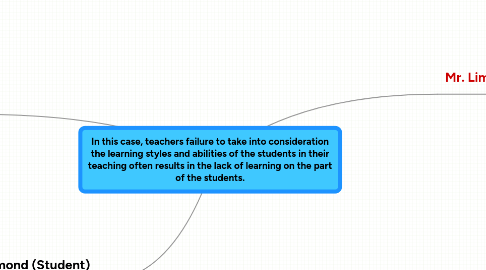
1. Beng Kwee (Student)
1.1. Problems
1.1.1. Did not understand Science lesson
1.1.2. He was not motivated to study
1.1.3. Science Lesson - Beng Kwee finds that the lesson is too boring and that it does not capture his attention. Thus, he is not interested in learning.
1.1.4. He did not have positive attitude. He put the blame on the teacher.
1.2. Solution
1.2.1. We should change Beng Kwee’s perception of what a great teacher can do and how his classmates and friends like James could play a part to change the learning environment.
1.2.1.1. Environmental Reinforcement- Bandura
1.2.1.2. Vygotsky's Teaching Strategies
1.2.2. Engaging Beng Kwee and the rest of the students in his teaching and giving them questions and problems that challenges their abilities, it stimulates the students’ curiosity and readiness to learn more.
1.2.2.1. Cognitive Development - Piaget
1.2.2.2. 6 Teaching Strategies - Vygotsky
2. Desmond (Student)
2.1. Problems
2.1.1. Demond do not understand Maths class when teacher just gave the formula straight and expect students to solve themselves
2.2. Solution
2.2.1. Teacher (Maths) could guide students in explaining the formula used and show them steps to problem solving.
2.2.1.1. Cognitive Development - Piaget
3. Mr. Lim (Teacher)
3.1. Problems
3.1.1. Didn't ask or find out why the students are not paying attention
3.1.2. He did not use any Learning Approaches or Theories
3.1.3. He talks without giving any examples or hands on activities
3.1.4. Did not assess student's level of ability when planning his lesson
3.1.5. Just drones on without knowing the students' performances
3.1.6. Get feedback on whether students know their work or subject understanding
3.2. Solutions
3.2.1. Mr Lim could make use of different learning tools such as the use of video to show students how his subject's theories can be translated into media so as to attract students and they will be able to understand the subject better and pay attention during his class.
3.2.1.1. Scaffolding Theory - Vygotsky
3.2.1.2. Social Learning Theory - Bandura
3.2.1.3. Adaptation Theory - Piaget
3.2.2. Mr Lim should find out the reasons to why his students were not able to pay attention during his lesson: 1. should change his approach to guiding his students and be more attentive towards his students’ learning needs. 2. would then engage hands-on activities during lesson so that he can get the students’ attention (He must remember this activity should be a continuation so that it influences the frequency of previously learned students)
3.2.2.1. Social Learning Theory - Bandura
3.2.2.2. Zonal Proximal Development (ZPD) - Vygotsky
3.2.2.3. Monitor and Encourage
3.2.3. Plan out a series of questions according to the level of difficulties so that Mr Lim will be able to gage the students' level of understanding. Which could engage Mr Lim with the different learning approaches and encourage him to communicate more with the students.
3.2.3.1. Effective Assessment through ZPD - Vygotsky
3.2.3.2. Skinner's Stimulus Response
3.2.4. Mr Lim could plan his lessons in a way that it engages the students’ interest in learning. For example a Science lesson on Volume, we could do some hands on experiment that . Discovery learning and supporting the developing interests of the students are two primary instructional techniques.
3.2.4.1. Learning through Modeling and Observation - Bandura
3.2.4.2. Cognitive Development - Piaget
